Agde round lock,
an original lock on the Canal du Midi
The round lock, a solution put forward by Riquet
The difficult Hérault crossing
A boat sailing from Toulouse to Sète would need to cross the Hérault river near the town of Agde. Upstream from the town, the river was blocked off by an embankment built by the bishops of Agde in the 14th century.
The waterfall this created was used to operate the bishops' mill on the left banks of the river. Therefore the water level of the river was kept constant up above the embankment. The constant depth made it an excellent place for navigation.
After some hesitation, Pierre-Paul Riquet chose to use the body of water for his navigation system. The boats arriving from Béziers would cross the river upstream from the embankment and then join onto the other side of the canal mouth, towards Thau lagoon.
But getting so close to the town of Agde, the gateway to the Mediterranean, without being able to go ashore was inconceivable for Riquet!
A round lock with three entrances

Ecluse ronde, Agde © VNF, Victor Tonelli
This special case needed an original solution and it was decided to build a round lock with three sets of gates.
The first led to the town of Sète and Thau lagoon via a short passage on the Hérault river; the second opened onto the canal coming from Béziers; and the third led to a 'canalet' that allowed small boats to reach the town of Agde and marina, then Grau d’Agde.
The round lock was put into service in 1678 when the canal was opened for navigation between Thau lagoon and Béziers. It measured 30 metres in diameter and was 5.20 m deep at the centre.
Thanks to this round lock and the lower 'canalet', small boats were able to reach the canal!

Plan avec écluse ronde d'Agde, 1759 © VNF, archives
Transformation of the lock in 1978
In 1978, the round lock was one of the locks that was modified in accordance with the Freycinet gauge. The purpose of this modernisation programme for the Canal du Midi was to allow 38.50-metre-long barges to navigate on the Canal du Midi.
The lock was therefore extended by 10 metres on one quarter of the circumference, which modified its remarkable initial shape. This modification may have altered the harmony of the original design, but it meant that large barges could now pass through the lock, and they still do today, between Béziers, Sète and Agde.













